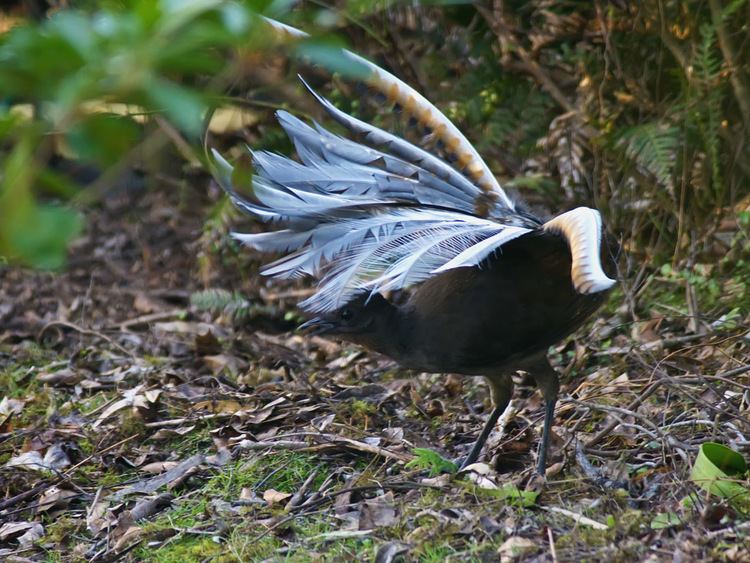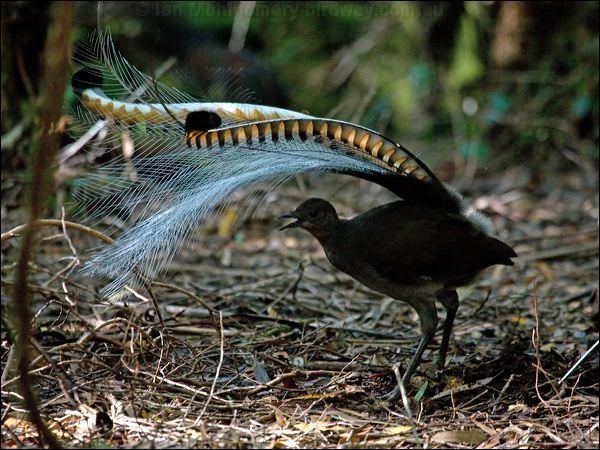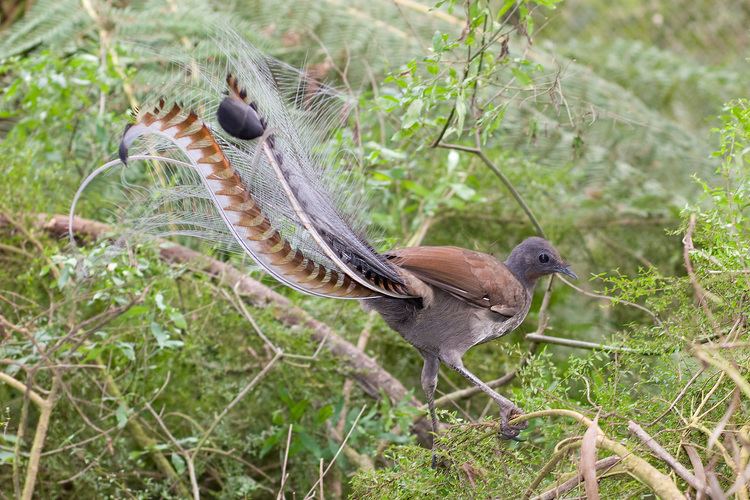Order Passeriformes Genus Menura Higher classification Lyrebird | Phylum Chordata Family Menuridae Scientific name Menura novaehollandiae Rank Species | |
 | ||
Similar Lyrebird, Bird, Albert's lyrebird, Passerine, Eastern yellow robin | ||
Superb lyrebird imitating construction work adelaide zoo
The superb lyrebird (Menura novaehollandiae) is an Australian songbird, one of two species from the family Menuridae. It is one of the world's largest songbirds, and is noted for its elaborate tail and excellent mimicry. The species is endemic to the south east of the country, and has been introduced to Tasmania.
Contents
- Superb lyrebird imitating construction work adelaide zoo
- The fanciest bird in the world superb lyrebird
- Distribution
- Description
- Behaviour
- Breeding
- Voice
- Ecology
- Taxonomy
- Museum specimens
- References

The superb lyrebird is featured on the reverse side of the Australian 10 cent coin.
The fanciest bird in the world superb lyrebird
Distribution

An Australian endemic, the superb lyrebird can be found in the forests of south-eastern Australia, from southern Victoria to south-eastern Queensland. Its diet consists mainly of small invertebrates found on the forest floor or in rotting logs. In the 1930s a small number were introduced to Tasmania amongst ill-founded fears it was in danger of becoming extinct. The Tasmanian population is currently thriving. Now widespread and common throughout its large range, the superb lyrebird is evaluated as being of least concern on the IUCN Red List of Threatened Species.
Description

The superb lyrebird is a pheasant-sized Australian songbird, with males measuring approximately 100 cm (39 in) long and females measuring 76 to 80 cm (30–31 in). Males weigh around 1.1 kg (2.4 lb), and females 890 g (1.96 lb). Among all extant songbirds only the common and thick-billed ravens regularly outweigh it and only the much more slender black sicklebill can rival its length. The plumage is brownish grey on upper body with a red-brown wash on the coverts and wings. The underparts are greyish-brown below. The wings are round and short, with a wingspan of 68 to 76 cm (27–30 in), and they are only capable of weak flight. The legs and feet are long and strong, and capable of running quickly on the ground and digging for food. The ornate tail of the male is 55 to 70 cm (22–28 in) long, and has sixteen feathers, with the two outermost together forming the shape of a lyre. Next within are two guard plumes and twelve long, lace-like feathers, known as filamentaries. Seven years are required for the tail to fully develop. During courtship displays, the male inverts his tail over his head, fanning his feathers to form a silvery white canopy. Young males and females have brown tail feathers which are camouflaged against the forest floor.
Behaviour

Superb lyrebirds are ground-living birds that typically live solitary lives. Adults usually live singly in territories, but young birds without territories may associate in small groups which can be single or mixed-sex. These groups may in turn travel for some time with territorial adults when they cross their territory.
Breeding

Superb lyrebirds breed in the depth of winter. Adult males start singing half an hour before sunrise from roosts high above the forest floor. Superb lyrebirds sing less often at other times of year but a stroll through their habitat on a rainy or misty day will sometimes find them active.

Superb lyrebirds have a promiscuous mating system. During the breeding season adult females and males defend separate territories and only females care for young. A female may visit several males before she mates but it is not known if she mates more than once. The female lays a single egg and builds a domed nest often camouflaging it with ferns or moss. The chick spends about nine months with the female before becoming independent.
Voice
The superb lyrebird has an extraordinary ability to accurately mimic a huge variety of sounds. Both male and female lyrebirds sing but males are louder and sing more often.
In David Attenborough's Life of Birds (ep. 6), the lyrebird is described as able to imitate twenty bird species' calls, and a male is shown mimicking a car alarm, chainsaw and various camera shutters.
A recording of a superb lyrebird mimicking sounds of an electronic shooting game, workmen and chainsaws was added to the National Film and Sound Archive's Sounds of Australia registry in 2013.
Ecology
Superb lyrebird are ecosystem engineers that are important for the overall health of the eucalyptus forests they live in. Their foraging behaviour changes the structure of the forest floor, speeding up the decay of forest litter and reducing the amount of fuel for forest fires.
Taxonomy
The superb is one of the two lyrebirds in the family Menuridae, the other being the much rarer Albert's lyrebird.
The scientific name has been previously given as Menura superba. The bird was first illustrated and described scientifically as such by Major-General Thomas Davies on 4 November 1800 to the Linnean Society of London. His work shows the tail feathers correctly displayed.
Lyrebirds are ancient Australian animals. The Australian Museum has fossils of lyrebirds dating back to about 15 million years ago. The prehistoric Menura tyawanoides has been described from early Miocene fossils found at the famous Riversleigh site.
Museum specimens
John Gould's painting of a male and female pair of superb lyrebirds, painted from specimens at the British Museum, has the tail feathers of the male incorrectly displayed.
A specimen of a male superb lyrebird, at the American Museum of Natural History, also has the tail feathers displayed incorrectly.
